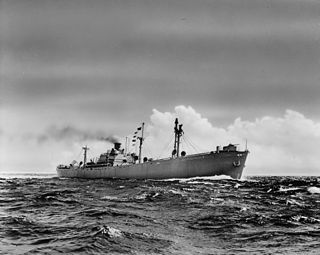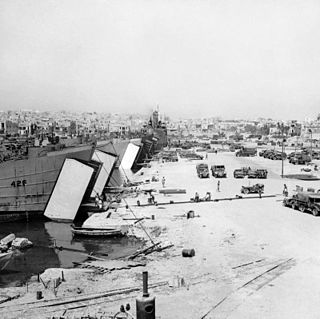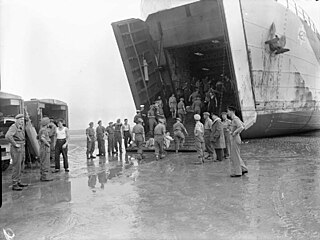
USS Cebu (ARG-6) was a Luzon-class internal combustion engine repair ship that saw service in the United States Navy during World War II. Named after Cebu, an island in the Philippines, it was the second ship of the Navy to bear this name.
SS Pierre L'Enfant was a Liberty ship built in the United States during World War II. She was named after Pierre L'Enfant, a French-American military engineer who designed the basic plan for Washington, D.C., known today as the L'Enfant Plan.
HMS LST-413 was a United States Navy LST-1-class tank landing ship that was transferred to the Royal Navy during World War II. As with many of her class, the ship was never named. Instead, she was referred to by her hull designation.

SS John Morgan was a World War II Liberty ship built by the Bethlehem Shipbuilding Corporation at their Bethlehem-Fairfield yard at Baltimore, Maryland, and launched on 4 May 1943. She was operated by the Wessel Duval & Company for the war.

HMS LST-409 was a Landing Ship, Tank Mk.2 of the Royal Navy during World War II.
HMS LST-412 was a United States Navy LST-1-class tank landing ship that was transferred to the Royal Navy during World War II. As with many of her class, the ship was never named. Instead, she was referred to by her hull designation.
HMS LST-414 was a United States Navy LST-1-class tank landing ship that was transferred to the Royal Navy during World War II. As with many of her class, the ship was never named. Instead, she was referred to by her hull designation.
HMS LST-415 was a United States Navy LST-1-class tank landing ship that was transferred to the Royal Navy during World War II. As with many of her class, the ship was never named. Instead, she was referred to by her hull designation.
HMS LST-416 was as a Landing Ship, Tank Mk.2 of the Royal Navy during World War II. Built as a LST-1-class tank landing ship for the United States Navy, it was transferred to the British in 1943 and returned to US in 1946.
HMS LST-418 was a United States Navy LST-1-class tank landing ship that was transferred to the Royal Navy during World War II. As with many of her class, the ship was never named. Instead, she was referred to by her hull designation.
HMS LST-421 was a United States Navy LST-1-class tank landing ship that was transferred to the Royal Navy during World War II. As with many of her class, the ship was never named. Instead, she was referred to by her hull designation.
HMS LST-423 was a United States Navy LST-1-class tank landing ship that was transferred to the Royal Navy during World War II. As with many of her class, the ship was never named. Instead, she was referred to by her hull designation.
HMS LST-424 was a United States Navy LST-1-class tank landing ship that was transferred to the Royal Navy during World War II. As with many of her class, the ship was never named. Instead, she was referred to by her hull designation.

HMS LST-425 was a United States Navy LST-1-class tank landing ship that was transferred to the Royal Navy during World War II. As with many of her class, the ship was never named. Instead, she was referred to by her hull designation.

HMS LST-426 was a United States Navy LST-1-class tank landing ship that was transferred to the Royal Navy during World War II. As with many of her class, the ship was never named. Instead, she was referred to by her hull designation.

HMS LST-427 was a United States Navy LST-1-class tank landing ship that was transferred to the Royal Navy during World War II. As with many of her class, the ship was never named. Instead, she was referred to by her hull designation.

HMS LST-428 was a United States Navy LST-1-class tank landing ship that was transferred to the Royal Navy during World War II. As with many of her class, the ship was never named. Instead, she was referred to by her hull designation.
HMS LST-429 was a United States Navy LST-1-class tank landing ship that was transferred to the Royal Navy during World War II. As with many of her class, the ship was never named. Instead, she was referred to by her hull designation.
HMS LST-430 was a United States Navy LST-1-class tank landing ship that was transferred to the Royal Navy during World War II. As with many of her class, the ship was never named. Instead, she was referred to by her hull designation.
SS St. Olaf was a Liberty ship built in the United States during World War II. She was named after St. Olaf, the King of Norway from 1015 to 1028. He was posthumously given the title Rex Perpetuus Norvegiae and canonised at Nidaros, by Bishop Grimkell, one year after his death in the Battle of Stiklestad.






